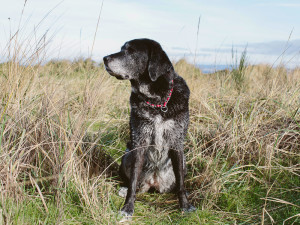What Is “Old Dog” Vestibular Disease, and How Is It Treated?
Senior dogs can get a condition called idiopathic “old dog” vestibular disease. Here's everything you need to know.

Share Article
In This Article:
What Is Vestibular Disease in Dogs? What Causes Vestibular Disease in Dogs? How Is Vestibular Disease in Dogs Diagnosed? What Are the Symptoms of Vestibular Disease in Dogs? Treatment for Vestibular Disease in Dogs Should You Put Down a Dog with Vestibular Disease?
When an older dog suddenly starts falling with their head tilted to one side, many pet parents assume the worst. Is it a stroke, seizure, or brain tumor? While it’s natural to fear these symptoms, they can also indicate a less serious condition called “old dog” vestibular disease, or idiopathic vestibular disease. It earned its name because it primarily affects senior dogsopens in new tab. (Most dogs diagnosed with this form of vestibular disease are more than five years old.)
The signs are identical to those of many other vestibular diseases. However, this one is unique in that it is considered idiopathic, meaning it has no clear underlying cause. Most of the time, treatment is aimed at keeping dogs comfortable, while controlling symptoms such as dizziness and nausea, until the condition resolves itself over a number of days.
Main takeaways
Vestibular disease is an umbrella term for many conditions affecting a dog’s balance.
“Old dog” vestibular disease, also known as idiopathic vestibular disease, primarily impacts elderly dogs and does not have a known underlying cause.
Most canines with “old dog” vestibular disease recover within a few weeks.
Still, any dog demonstrating a loss of balance or other vestibular or neurological issues should see a vet right away.
What is vestibular disease in dogs?
Vestibular disease in dogs is a balance disorder similar to vertigo in people. Common symptoms include a head tilt, nausea, rapid eye movements known as nystagmus, and difficulty walking (or even standing). Idiopathic vestibular disease is the most commonly diagnosed form of vestibular disease in pets.
How much do you spend on your pet per year?

With idiopathic vestibular disease, the cause is typically unknown, and treatment is focused on supportive care. However, causes of (non-idiopathic) vestibular disease in dogs may include inner ear infectionsopens in new tab, hypothyroidismopens in new tab, tumorsopens in new tab, stroke, certain infections, and/or traumatic injuries to the brain or nerves.
Are some breeds more at risk for vestibular disease?
Any breed can be susceptible to idiopathic vestibular disease, and there are no breeds who are more at risk. However, (non-idiopathic) vestibular disease is more likely in breeds who are predisposed to ear infections. They include Cocker Spaniels, Boston Terriers, Boxers, Shar Peis, Poodles, Golden Retrievers, Labrador Retrievers, Beagles, Basset Hounds, and other brachycephalic dogsopens in new tab such as French Bulldogs, Pugs, and Pekingese.
What causes vestibular disease in dogs?
The vestibular system is a series of fluid-filled tubes and receptors in the inner ear that help with balance. When this system is disrupted, dogs feel dizzy, cannot tell which way is up, and have trouble standing and walking.
The vestibular system may be disrupted within the brain, where this information is processed. This can be caused by traumatic injuries to the brain as well as certain infections, strokes, and/or brain tumors.
But it can also be disturbed peripherally (or outside of the brain): in the inner ear, where the vestibular system is located, or along the route of nerves that transmit messages and reactions. This can occur due to traumatic injuries, inner ear infections, reactions to certain medications, and hypothyroidismopens in new tab.
Although idiopathic vestibular disease is a peripheral condition, it does not have a known cause. However, it’s thought to be due to physical changes in the vestibular system that occur with age.
How is vestibular disease in dogs diagnosed?
Vestibular disease is diagnosed based on observed symptoms. Dogs who exhibit signs such as a head tilt, nystagmus (rapid eye movements), and loss of balance — but have normal awareness and movement of their limbs — are likely to have a peripheral vestibular problem. This means the problem is not within the brain but in the periphery, such as with the inner ear.
When a dog shows these signs, a veterinarian will try to determine the underlying causeopens in new tab through a physical exam, by conducting bloodwork (to check for conditions like hypothyroidismopens in new tab and infections), and by checking for an inner ear infection. In some cases, advanced imaging, such as an MRI, may be recommended to rule out other conditions.
If the vet suspects that the dog has idiopathic vestibular disease, pet parents are often advised to monitor their pet for 72 hours to see if the condition starts improving before investing in expensive, and possibly unnecessary, diagnostic tests. However, in cases where the vet suspects a central vestibular problem (ie within the brain), these additional tests are necessary to determine the underlying cause.
Rule out common diseases
Idiopathic disease can only be diagnosed by ruling out the other causes of vestibular disease. With this in mind, your veterinarian may recommend a complete check-up (including a thorough physical exam, bloodwork, urinalysis, and ear cytology) to look for infections and other issues.
Check for ear infections
Inner ear infections are relatively common causes of vestibular disease. When the inner ear is inflamed, it can interfere with the vestibular system, which is located in the same area. But diagnosing an inner ear infection is complicated, since this part of the ear cannot be easily accessed.
To look for signs of an inner ear infection, both ear canals are examined. The presence of an outer ear infection can be a clue that there is also inner ear disease. Technically, you can’t see the inner ear during an ear exam because the eardrum obscures the view. But when there is severe inner-ear disease, your vet may be able to see signs of inflammation and/or pus on the inner surface of the eardrum. Additional tests can help evaluate the inner ear, including X-rays of your dog’s head, obtaining a fluid sample from the inner ear, and/or advanced imaging like an MRI.
Use diagnostic imaging tools
Your vet may discuss using advanced imaging, such as an MRI, to evaluate the inner ear and brain. This is a very useful and effective diagnostic tool, however, it does have some drawbacks.
First, the machine is usually only available at specialty hospitals, emergency referral centersopens in new tab, and academic institutions (like veterinary schools). Second, dogs need to be completely still for the procedure, which means they must be anesthetized. Not every dog is a good candidate for anesthesia, so for dogs with multiple underlying medical conditions, the risks may outweigh the benefits. Third, for all of the reasons listed here, this is an expensive diagnostic test. It typically costs upwards of $1,500 for the procedure, including anesthesia and the time your dog will spend in the hospital. For this reason, an MRI is best reserved for dogs suspected of having a central vestibular issue in their brain, or for vestibular disease that is either not improving after many days or is getting worse.
Wait and see
As a rule of thumb, if there is gradual improvement within 72 hours, the dog likely has idiopathic vestibular disease and additional testing is not necessary. It can take a few weeks for signs to completely resolve, and some dogs may have a persistent head tilt even after they seem recovered. If there is no improvement, or they seem to be getting worse and/or developing additional symptoms, additional testing is recommended.
What are the symptoms of vestibular disease in dogs?
Dogs with idiopathic vestibular disease typically show some combination of the following signs:
A head tilt, in which a dog’s head may seem permanently tipped to one side
An unsteady gait, loss of balance, or falling over known as ataxia
Circling in one direction, or walking in circles
Eyes rapidly moving from side to side, known as nystagmus
Drooling or vomitingopens in new tab, secondary to nausea and dizziness
Standing with legs spread wide to stabilize their balance
Changes in eating or drinking habits
Dogs with ear infections may also show signs of painopens in new tab when their ears are touched, exhibit head-shakingopens in new tab, and have a bad odor (or discharge) in their ears.
Dogs who have a central vestibular problem may have all of the above symptoms alongside additional ones such as changes in their awareness, deficits in their motor function, seizuresopens in new tab, and more. In these cases, your vet may run tests to differentiate a central vestibular problem from a peripheral one.
Treatment for vestibular disease in dogs
Treatment for vestibular disease is based on the underlying cause. In cases where a specific reason for the condition is identified, you must follow your vet’s treatment plan consistently to help your dog recover.
On the other hand, when it comes to idiopathic vestibular disease, most dogs make a full recovery without any specific treatment. During the first few days of their illness, your dog may feel really awful from all the dizziness. Your vet can provide supportive care that will help with these symptoms, including medications for nausea and motion sickness. They may also recommend supplementing with fluids, either through an IV or under the skin, to help your pup stay hydrated if they are not eating and drinking normally.
Home remedies for vestibular disease in dogs
It is important to get a diagnosis from your vet before attempting to treat your pup at home. This is because many of the factors that cause vestibular disease, both centrally and peripherally, can look similar at first — and you want to be sure to give your dog more specific treatment, if needed.
Once your dog is at home recovering, there are several things you can do to support them.
Set up a specific room or block off an area that will be your pup’s recovery pad. If they are extremely dizzy and unable to walk much, you’ll want to make everything very accessible to them.
Block off any trip hazards, stairs, or open water (like pools and ponds) to prevent accidental falls and injuries.
Keep their water and food bowls close, so they don’t need to walk far.
Provide lots of soft, thick bedding so your dog doesn’t get injured if they fall over. For dogs who are not able to stand at all, rotate their position every few hours and switch which side they are laying on to prevent pressure injuries. Also, make sure their bedding is clean and dry, and replace any soiled bedding right away to prevent skin irritation.
Encourage their appetite by adding tasty food toppers like bone brothopens in new tab to their meals, and offer them extra-yummy foods to tempt them. Just be sure to check that all ingredients are safeopens in new tab for your pup.
Use a body harness with a handle to keep them steady for short walks.
Should you put down a dog with vestibular disease?
This is a complex question that needs to be considered in context of your dog’s specific diagnosis, while thinking about their quality of life.
You should definitely not put down your dog if their vestibular disease is idiopathic, because they will likely improve within a matter of days. As you see your pup improving, it will get easier and easier to care for them.
In cases where a dog’s vestibular disease is suspected to have a more long-term or potentially terminal diagnosis, such as a brain tumor, it is important to consider what’s most humane for them and how to best maintain their quality of life. In some cases, effective treatment options are available, while in other cases, palliative care may be the best approach. Be sure to speak with your vet about all of these considerations, and make a plan that honors both you and your pup’s needs.
How long can dogs live with vestibular disease
The amount of time a dog will live with vestibular disease depends on the specific cause of their condition. Idiopathic vestibular disease does not typically shorten a dog’s life expectancy at all. After recovery, dogs with idiopathic vestibular disease continue to live normal lives, although they may have mild residual signs such as a head tilt.
If a dog’s vestibular disease is caused by a brain tumor or severe head injury, the long-term prognosis may be more uncertain. In these cases, it is very important to consult your veterinarian to understand what to expect in the future.
Is vestibular disease fatal?
Idiopathic vestibular disease is not fatal. A majority of dogs will make a complete recovery within a few weeks even without any treatment. However, since there are so many possible causes for vestibular disease, it is important to understand that some of these (such as tumors, severe head trauma, and certain types of infections) can be very serious and in some cases, fatal.
Can “old dog” vestibular disease be prevented?
Idiopathic, or old dog, vestibular disease cannot be prevented. The reason it occurs is unknown, but it is suspected to be related to changes in the vestibular system that simply occur with age. Some forms of vestibular disease (such as hypothyroidism and ear infections) can be prevented through early screening and treatment.
By staying on schedule with your dog’s routine physical exams and bloodworkopens in new tab, you can catch, and get treatment for, minor conditions (such as ear infections) right away to prevent them from escalating. As always, keeping your dog healthy with a high-quality dietopens in new tab, daily exercise, and mental enrichmentopens in new tab is a great way to prevent many health problems throughout life.
FAQs
What is the vestibular system?
The vestibular system is a series of highly specialized fluid-filled tubes, receptors, and nerve endings within the inner ear. This system helps regulate a dog’s balance.
Is vestibular disease similar to vertigo?
Yes, vertigo is a term used in human medicine to describe the same phenomenon.
Why is it called “old dog” vestibular disease?
The condition is called “old dog” vestibular disease because it is most common in dogs, more than five years old and may be related to changes that occur due to age. “Old dog” vestibular disease is actually another name for idiopathic vestibular disease.
How to tell the difference between a stroke and vestibular disease in dogs?
While a stroke can cause signs of vestibular dysfunction in dogs, a stroke will also cause other abnormalities consistent with a central problem within the brain. Your vet can determine if your dog’s signs are consistent with a peripheral vestibular problem or a central vestibular problem during a physical exam. To definitively diagnose a stroke or other problem within the brain, advanced imaging like an MRI is typically required.
Bottom line
“Old dog” vestibular disease, aka idiopathic vestibular disease, is a self-limiting condition that usually resolves on its own within a few weeks.
It is very important to have your vet diagnose the condition. Because there are many other causes of vestibular disease, some dogs will require additional testing and treatment.
References
Brooks, Wendy. “Vestibular Disease in Dogs and Catsopens in new tab.” Veterinary Partner. September 24, 2019.
Michaels, Jennifer. “Acute Vestibular Disease in Old Dogsopens in new tab.” MSPCA-Angell.
Orlandi, R., et al. “Clinical signs, MRI findings and outcome in dogs with peripheral vestibular disease: a retrospective studyopens in new tab.” BMC Veterinary Research, vol. 16, no. 159, 2020.
Sinziana, Maria Radulescu. “Vestibular disease in dogs under UK primary veterinary care: Epidemiology and clinical managementopens in new tab.” Journal of Veterinary Internal Medicine, vol. 34, no. 5, 2020, pp. 1993-2004.

Dr. Shea Cox, DVM, CVPP, CHPV
Dr. Shea Cox is the founder of BluePearl Pet Hospice and is a global leader in animal hospice and palliative care. With a focus on technology, innovation and education, her efforts are changing the end-of-life landscape in veterinary medicine.

Dr. Amy Fox, DVM
Amy Fox, DVM is a small animal veterinarian in New York City with over thirteen years of experience in a mixture of general practice, emergency medicine, and shelter medicine. A lifelong animal lover, Dr. Fox studied biology in college and then worked as a veterinary nurse before pursuing veterinary school at Cornell University. Her expertise includes surgery, dentistry, and management of chronic conditions, and she is interested in toxicology, pain management, nutrition, care of senior pets, and educational outreach. Dr. Fox also enjoys writing about veterinary medicine and teaching, and her work has previously appeared in Spruce Pets. In her free time, she loves to cook, garden, go for long runs, and hang out with her goofy mixed-breed dog May, who provides never ending comic relief!
Related articles
![close up of Chihuahua dog's eye with cataracts]()
Common Eye Problems in Dogs and How to Treat Them
Your dog sees you as their best friend, so keep those eyes healthy.
![Dog playing the shell game with her human. Concept of training pets, domestic dogs being smart and educated]()
4 Ways to Keep Your Dog Busy When They Can’t Exercise
Even if your dog is injured and can't exercise, you can still keep them entertained. Here's how.
![Dog standing in an animal shelter]()
“Should I Adopt an Adult Rescue Dog?”
Yes! Shelters are full of good, grown-up doggos. Here’s how to find the perfect match.
![Brown dog with golden eyes leaning on fence]()
Is Your Senior Dog Sundowning?
If your senior dog seems confused, restless, or irritable after dark, they may have sundowners syndrome. Here’s how to deal.
![Smiling veterinarian examining medical documents of a Bulldog standing on her examination table]()
How to Give Your Dog a Blissful Vet Visit
Reduce the stress of veterinary visits — for you and your pup.
![A vet holding medicine near a dogs face]()
How to Find a Veterinary Specialist
Just like your doctor would refer to you a specialist for expert care for a complicated issue, your vet may do the same for your dog.







